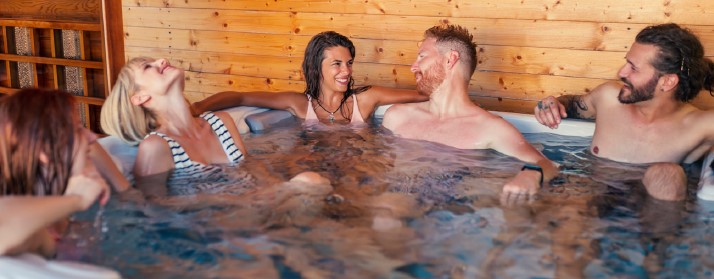membership
Contracting the Facts
Three experts provide information about recreational waterborne illnesses pool operators need to help people swim with confidence

Every summer, the same ideas circulate in articles across mainstream media — tips for vacation planning, recipes for barbecues, advice for summer parenting challenges, and all the ways spending time in swimming pools could kill you.
This summer won’t be any different. Prepare for your social media feeds to be filled with frightening headlines and suggestions that if you swim in a public pool, you may get one of several gastrointestinal (GI) diseases. While pool or hot tub risks should not be downplayed or ignored, they also should not be overstated or sensationalized. Here’s an honest review of swimmers’ chances of contracting recreational waterborne illnesses (RWIs) and how to prevent them.
Understanding the data
 Franceen Gonzales
Franceen Gonzales
In a recent CDC study, researchers analyzed the source and impact of infectious diseases caused by 17 waterborne pathogens in 2014. Of 7.15 million reported cases, 5.61 million illnesses acquired in the U.S. were linked to recreational water.
However, “recreational water” includes both treated swimming pools, hot tubs, and splash pads and untreated natural waters such as lakes, rivers, reservoirs, or oceans. Since the report doesn’t indicate which illnesses can be attributed to pools or hot tubs, the risks from swimming in these settings can’t be accurately determined. A distinction between residential and commercial pools could also be helpful.
“Commercial pools and hot tubs are more predictable,” said pool safety/water science expert and president of LEGOLAND Florida Resort Franceen Gonzales. “Although they have more people in the pool, they are regulated by a health department. Additionally, those commercial settings often have systems that control the chemical levels automatically.”
"Commercial pools and hot tubs are more predictable. Although they have more people in the pool, they are regulated by a health department. Additionally, those commercial settings often have systems that control the chemical levels automatically."
- Franceen Gonzales
How pool owners can reduce the risks
 Jody O'Grady
Jody O'Grady
Ultimately, the risk of encountering RWIs in a pool or hot tub is dependent on how well the water is maintained. When owners and operators take the appropriate measures, including proper chlorination with regular testing, water circulation, and filtration, APi Water director of commercial sales Jody O’Grady believes “it’s safe to say you could cut your risk in half.”
Swimmers should be reassured by the role chlorine plays in protecting them from illnesses. Chlorine works to inactivate germs or pathogens in water. If operators are doing their job, they’ll maintain the necessary levels of chemicals to inactivate pathogens.
“The most important result to look at is free chlorine,” said O’Grady, who chairs PHTA’s Recreational Water & Air Quality Committee. “To have enough free chlorine in the water, there will be one to two parts per million of chlorine, depending on if you’re using cyanine acid or not.”
O’Grady and Gonzales both stressed the importance of ensuring adequate pH levels, which should be between 7.2 and 7.8.
“If the pH is right, the chlorine is doing its work,” said Gonzales. “Too high of pH and chlorine will not work well. Too low, and that’s going to be less comfortable for people.”
Beyond maintaining appropriate chemical levels, operators will want to filter and circulate water to remove contaminants.

How swimmers can reduce their risks
When it comes to avoiding sicknesses at the swimming pool, there are several steps swimmers can take.
First, decide if you want to swim. There are multiple ways to learn whether a pool or hot tub is properly maintained.
- The smell of chlorine. “Smelling a little chlorine isn’t bad. However, a strong chlorine smell in an indoor pool could be the smell of chlorine byproducts — chemicals that form when chlorine interacts with bathers’ sweat and/or urine,” said Gonzales. “Too much byproduct could lead to red eyes, throat irritation, or difficulty breathing. This can be remedied with added fresh water, UV light, or improved ventilation.”
- Dirty water. “If you see water that looks green or a bunch of stuff at the bottom of the pool, I’d be asking questions,” she said. “But there are a lot of things you just can’t see, like germs in the water.”
- A lack of testing or test results. Many commercial pools post their chlorine and pH levels after testing the water, which should be done multiple times a day. If you never see results or lifeguards conducting water tests, that could be a red flag.
- Test yourself. Swimmers always have the option to test the water themselves with store-bought test kits. In fact, they may want to test before using a pool or hot tub at a rental property. “Rental owners should make sure there’s adequate sanitizer and proper water balance before their next guest arrives,” said O’Grady. “But how do you ensure that? The only way you can really know the water is okay is to test it yourself.”
Swimmers also have a responsibility to know what they bring into the pool.
 Heather Murphy, Ph.D., P.Eng.
Heather Murphy, Ph.D., P.Eng.
“Often the contamination of pool water comes from the swimmers, rather than the water itself,” said Heather Murphy, Ph.D., P.Eng., expert in water, health, and applied microbiology and associate professor at University of Guelph.
If you are sick, staying home will keep others healthy. In addition to germs, swimmers may bring dirt, hair product, and sunscreen into the pool — all of which will break down chlorine over time. Taking a shower before swimming helps prevent this.
Understanding diseases
It’s easy to see why this topic comes up each year. Nobody wants to get sick from swimming. Reviewing the data with an understanding of diseases can provide reassurance.
According to the CDC study, of the waterborne illnesses linked to recreational water, 79% caused swimmer’s ear and 21% caused GI illnesses.
Swimmer’s ear
While there are many causes for swimmer’s ear, one major cause is bacteria such as Pseudomonas aeruginosa. This is important, said O’Grady, because “chlorine can inactivate Pseudomonas in minutes.”
Because of this, O’Grady and Murphy agree most reported swimmer’s ear cases were likely contracted in untreated natural bodies of water or swimming pools with insufficient chlorine.
However, as the study acknowledges, swimmer’s ear can also occur when water displaces protective ear wax, leaving the outer ear vulnerable to infection from unknown sources. To prevent this, swimmers can wear ear plugs in the pool and dry their ears after swimming.
GI illnesses
The smallest type of organism that causes GI illnesses is a virus, like norovirus.
“They’re pretty wimpy when it comes to chlorine and get knocked out pretty easily,” said Murphy. “But they can survive in fresh water.”
Next in size is bacteria, such as pathogenic E. coli or Campylobacter, which Murphy also described as “wimpy” against chlorine.
"If pools are pulling from a municipal water system where water has already been treated, it should be pretty safe."
- Heather Murphy, Ph.D., P.Eng.
Larger than bacteria are protozoan parasites like Cryptosporidium and Giardia. Because these organisms have hard cyst structures in their cells, they can be resistant to chlorine. These parasites can be present if an ill swimmer defecates in the pool. In these cases, operators should close the pool until it can be cleaned and shock chlorinated.
Pools that source their water from untreated surface water or groundwater should consider investing in a filtration system or UV light.
“If pools are pulling from a municipal water system where water has already been treated, it should be pretty safe,” said Murphy.
Understanding the benefits

To swim or not to swim? Swimmers must make their own choices after evaluating the risks.
“The only way to get to zero risk is to not swim,” said O’Grady, adding that drowning is the number one cause of death in children ages one to four. “But we can mitigate the risk of illnesses with proper sanitization, circulation, infiltration, and verifying with testing.”
And consider the potential benefits.
“What about the joy of recreating in water through forming relationships with your family, getting exercise, being part of a community, learning new skills?” O’Grady asked. “Do all of those benefits outweigh the small risk?”








